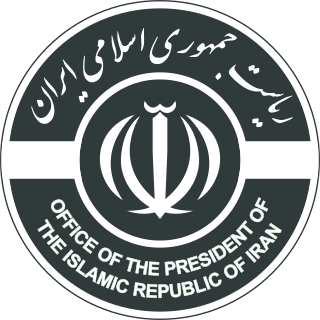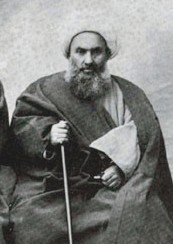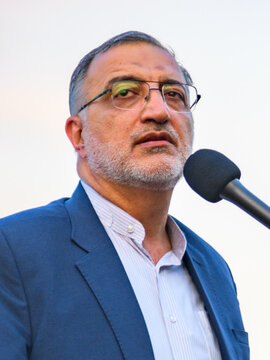
The president of Iran is the head of government of the Islamic Republic of Iran. He is the second highest-ranking official, after the Supreme Leader. The first election was held in 1980 and Abulhassan Banisadr won. Mohammad Mokhber, the first vice president, is acting as president following the death of Ebrahim Raisi on 19 May 2024.

Ali Ardeshir Larijani is an Iranian moderate politician, philosopher and former military officer in the Islamic Revolutionary Guard Corps, who served as the Speaker of the Parliament of Iran from 2008 to 2020. He has been a member of the Expediency Discernment Council since 2020, having previously served from 1997 to 2008. Larijani is a candidate for president of Iran in the 2024 presidential election. He previously ran in 2005 and 2021.

The Imam Sadiq University is an Islamic private university in Tehran, Iran. Established in 1982, the goal of the university is to bridge the gap between Islamic research and modern studies, especially humanities. The university was dedicated to training politicians and jurists preaching Islam. Reflecting its commitment to Islamic principles, the university separates educational environments for female and male students.

Ahmad Masjed-Jamei is an Iranian reformist politician and academic who was chairman of City Council of Tehran from 3 September 2013 until 3 September 2014. He served as Culture Minister under President Mohammad Khatami from 2000 to 2005. He was elected a Tehran City Councillor in 2006 and was reelected in 2013.

Islamic Clericalism in Iran has a long history and had a remarkable impact on Iranian society, politics as well as on Islamic theology.

Mir-Hossein Mousavi Khameneh served as the last Prime Minister of Iran, from 1981 to 1989, before the position was abolished in the 1989 review of the Iranian constitution. In the years leading up to the Islamic Revolution, Mousavi and his wife, Zahra Rahnavard, moved to the United States; they returned to Iran shortly after the establishment of the Islamic Republic.

The Cabinet of Iran is a formal body composed of government officials, ministers, chosen and led by the President of Iran. Its composition must be approved by a vote in parliament. According to the Constitution of the Islamic Republic of Iran, a president may dismiss members of the cabinet, but must do so in writing, and new appointees must again be approved by parliament. The cabinet meets weekly on Saturdays in Tehran. There may be additional meetings as circumstances require. The president chairs them. The Supreme Leader of Iran Ali Khamenei has the power to dismiss cabinet members like ministers, vice presidents and presidents at any time, regardless of parliamentary decisions.

Presidential elections were held in Iran on 14 June 2013. Hassan Rouhani was elected in the first round of voting with 52% of the vote. Tehran Mayor Mohammad Bagher Ghalibaf finished second with 17% of the vote. Voter turnout was 73%.

Mohammad Shariatmadari is an Iranian politician and former Minister of Cooperatives, Labour and Social Welfare. He was in position of minister of Industry, from 2017 to 2018. He also served as minister of commerce from 1997 to 2005 in the cabinet of President Mohammad Khatami. He was campaign chairman of Hassan Rouhani for 2017 bid.

Alireza Zakani is an Iranian conservative politician, current mayor of Tehran since 2021 and Aide to the president of Iran in affairs of management of social damages in Tehran city since 2023.

Akbar Hashemi Rafsanjani served as the fourth president of Iran from 1989 until 1997.

Hassan Rouhani, a moderate Iranian politician and former Secretary of the Supreme National Security Council, also known as the Diplomat Sheikh, launched his presidential campaign in March 2013. He was earlier expected to withdraw and endorse Ali Akbar Hashemi Rafsanjani after he registered, but he returned to the race after Hashemi's disqualification. The symbol of Rouhani's campaign was a key and his slogan was "Government of Prudence and Hope." On 15 June, he was elected as the president with 18,613,329 votes.

Front of Followers of the Line of the Imam and the Leader, formerly known as Islamic Aligned Organizations is a Coalition of Iranian Principlist political groups. The group which consists of a wide range of traditional conservative parties, is active since administration of Mohammad Khatami, and is aligned with The Two Societies.

Hassan Rouhani, the incumbent president of Iran, launched his reelection campaign for the presidential office in February 2017. The election itself and related events received international media attention with many issues being raised. Rouhani achieved a decisive victory after the May 2017 vote, with Interior Minister Abdolreza Rahmani Fazli announcing that out of 41.3 million total votes cast Rouhani got 23.6 million. Ebrahim Raisi, Rouhani's closest rival, had picked up 15.8 million votes in contrast.
The Ebrahim Raisi 2017 presidential campaign began when Ebrahim Raisi, chairman of the Astan Quds Razavi, launched his campaign for the 2017 presidential election. Raisi's campaign pursued a populist agenda.

Presidential elections were held in Iran on 18 June 2021, the thirteenth since the establishment of the Islamic Republic in 1979. Ebrahim Raisi, the then Chief Justice of Iran, was declared the winner in a highly controversial election. The election began with the mass disqualification of popular candidates by the Guardian Council, and broke records of the lowest turnout in Iranian electoral history, as well as had the highest share of protest blank, invalid and lost votes despite a declaration by the Supreme Leader of Iran, Ali Khamenei, considering protest voting religiously forbidden (haraam) as it would "weaken the regime." Reporters Without Borders reported 42 cases of journalists being summoned or threatened for writing about candidates, and the chief of the police threatened people who discouraged others to vote.
















